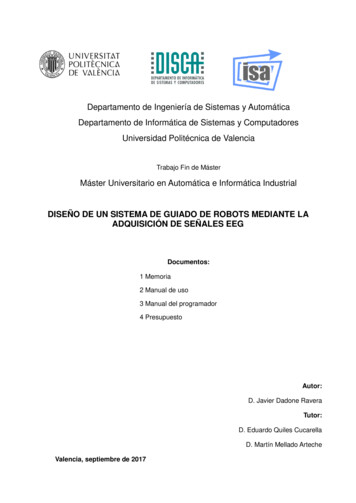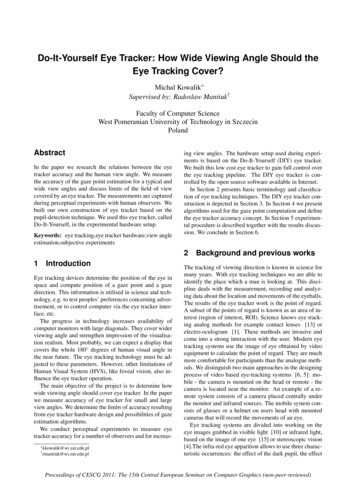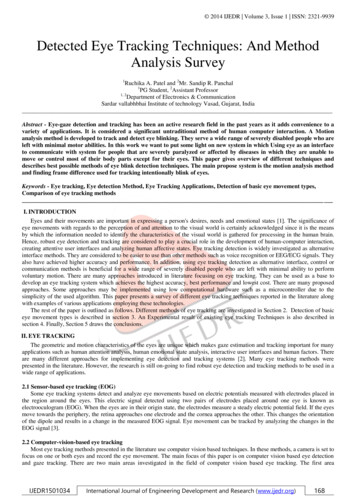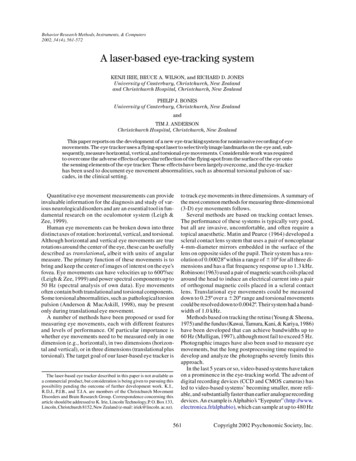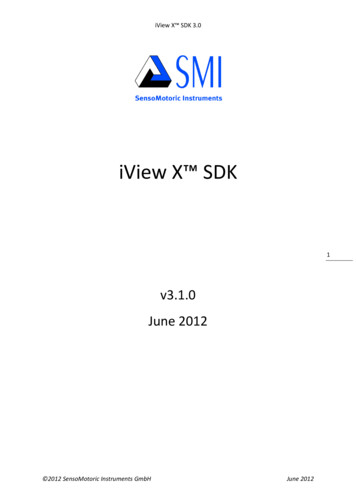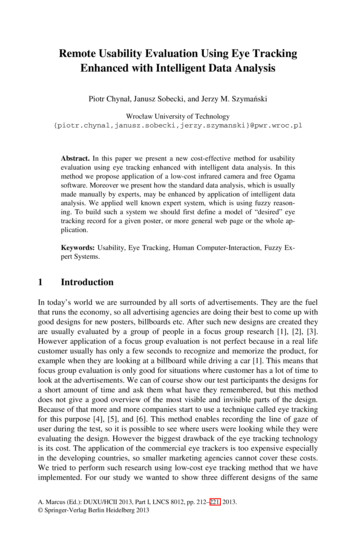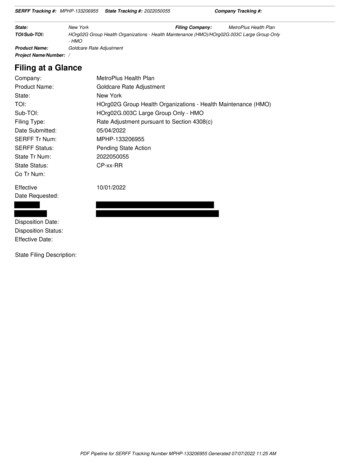Transcription
ORIGINAL RESEARCHpublished: 20 November 2020doi: 10.3389/fnhum.2020.595890SSVEP BCI and Eye Tracking Use byIndividuals With Late-Stage ALS andVisual ImpairmentsBetts Peters 1,2* , Steven Bedrick 1,3,4 , Shiran Dudy 1,4 , Brandon Eddy 1,2 , Matt Higger 5 ,Michelle Kinsella 1,2 , Deirdre McLaughlin 1,2 , Tab Memmott 1,6 , Barry Oken 1,6 ,Fernando Quivira 7 , Scott Spaulding 1,8 , Deniz Erdogmus 1,9 and Melanie Fried-Oken 1,21Consortium for Accessible Multimodal Brain-Body Interfaces (CAMBI), Portland, OR, United States, 2 REKNEW Projects,Institute on Development & Disability, Department of Pediatrics, Oregon Health & Science University, Portland, OR,United States, 3 Department of Medical Informatics and Clinical Epidemiology, Oregon Health & Science University, Portland,OR, United States, 4 Center for Spoken Language Understanding, Institute on Development and Disability, Department ofPediatrics, Oregon Health & Science University, Portland, OR, United States, 5 Khoury College of Computer Science,Northeastern University, Boston, MA, United States, 6 Department of Neurology, Oregon Health & Science University,Portland, OR, United States, 7 Independent researcher, Boston, MA, United States, 8 College of Education, University ofWashington, Seattle, WA, United States, 9 Cognitive Systems Laboratory, Center for Signal Processing, Imaging, Reasoning,and Learning (SPIRAL), Department of Electrical and Computer Engineering, Northeastern University, Boston, MA,United StatesEdited by:Chang-Hwan Im,Hanyang University, South KoreaReviewed by:Yijun Wang,Institute of Semiconductors (CAS),ChinaChang-Hee Han,Technical University of Berlin,Germany*Correspondence:Betts Peterspetersbe@ohsu.eduSpecialty section:This article was submitted toBrain-Computer Interfaces,a section of the journalFrontiers in Human NeuroscienceReceived: 17 August 2020Accepted: 30 September 2020Published: 20 November 2020Citation:Peters B, Bedrick S, Dudy S,Eddy B, Higger M, Kinsella M,Mclaughlin D, Memmott T, Oken B,Quivira F, Spaulding S, Erdogmus Dand Fried-Oken M (2020) SSVEP BCIand Eye Tracking Use by IndividualsWith Late-Stage ALS and VisualImpairments.Front. Hum. Neurosci. 14:595890.doi: 10.3389/fnhum.2020.595890Access to communication is critical for individuals with late-stage amyotrophic lateralsclerosis (ALS) and minimal volitional movement, but they sometimes present withconcomitant visual or ocular motility impairments that affect their performance with eyetracking or visual brain-computer interface (BCI) systems. In this study, we explored theuse of modified eye tracking and steady state visual evoked potential (SSVEP) BCI, incombination with the Shuffle Speller typing interface, for this population. Two participantswith late-stage ALS, visual impairments, and minimal volitional movement completed asingle-case experimental research design comparing copy-spelling performance withthree different typing systems: (1) commercially available eye tracking communicationsoftware, (2) Shuffle Speller with modified eye tracking, and (3) Shuffle Speller withSSVEP BCI. Participant 1 was unable to type any correct characters with thecommercial system, but achieved accuracies of up to 50% with Shuffle Speller eyetracking and 89% with Shuffle Speller BCI. Participant 2 also had higher maximumaccuracies with Shuffle Speller, typing with up to 63% accuracy with eye tracking and100% accuracy with BCI. However, participants’ typing accuracy for both Shuffle Spellerconditions was highly variable, particularly in the BCI condition. Both the Shuffle Spellerinterface and SSVEP BCI input show promise for improving typing performance forpeople with late-stage ALS. Further development of innovative BCI systems for thispopulation is needed.Keywords: augmentative and alternative communication, vision disorders, brain-computer interface, steady statevisual evoked potential, eye tracking, amyotrophic lateral sclerosisINTRODUCTIONAmyotrophic lateral sclerosis (ALS) is a progressive neurodegenerative disease that affectsvoluntary motor function. The course of disease progression and life expectancy vary considerablyfrom person to person, but a majority of people with ALS (PALS) lose the ability to speak,and thus may benefit from augmentative and alternative communication (AAC) approachesFrontiers in Human Neuroscience www.frontiersin.org1November 2020 Volume 14 Article 595890
Peters et al.BCI Eye Tracking ALS(Peters et al., 2018a). All participants were able to use thesystem with a simulated visual acuity impairment of 20/200(the level associated with legal blindness in the United States),with no significant effect on typing accuracy or speed comparedto an unimpaired control condition. Performance under asimulated ocular motility impairment condition was morevariable, with only a small number of participants (6/37) ableto type successfully. For participants who were successful underthis condition, typing accuracy was comparable to performanceunder the unimpaired condition, but speed was greatly reduced,reflecting Shuffle Speller’s adaptations (increased trial length andmore trials per decision) to more ambiguous user input signals.In this work, we describe a new experiment to explore theuse of Shuffle Speller, with eye tracking and SSVEP BCI, byindividuals with late-stage ALS who have minimal volitionalmovement, impaired ocular motility, and other concomitantvisual challenges. Individuals with this level of impairmentwould be classified as stage 4 according to both the King’sclinical staging scale (nutritional or respiratory failure) and theMiToS ALS functional staging scale (loss of independence inthe four domains of the ALSFRS-R) (Roche et al., 2012; Chiòet al., 2015), and may present with incomplete, classic, or totallocked-in syndrome. This experiment serves as a feasibility studydemonstrating the potential of the Shuffle Speller interface, aswell as SSVEP BCI, to support communication by individualswith ALS presenting with locked-in syndrome.Initially, a pilot study was conducted to investigatethe feasibility of Shuffle Speller as an AAC interface inthis population. Three PALS with poor eye tracking SGDperformance were included as participants. Two of the threeshowed marked improvement in typing accuracy under theShuffle Speller conditions, with both eye tracking and SSVEPBCI, compared to baseline performance with a commercialeye tracking SGD. The third showed reduced variability inperformance and a higher overall mean accuracy for ShuffleSpeller eye tracking compared to baseline (Peters, 2019).For the current study, an alternating-treatments single-caseexperimental research design was used to assess whether ShuffleSpeller, accessed with either SSVEP BCI or modified eye tracking,allowed more accurate typing than a similar typing interfaceaccessed with traditional eye tracking for individuals with ALSand visual impairments.(Beukelman et al., 2011; Fried-Oken et al., 2015a). Loss offunction in the upper extremities often necessitates the use ofalternative access methods (Gibbons and Beneteau, 2010). Sincemost PALS maintain adequate ocular motility even as othervoluntary motor function deteriorates, they are often prescribedeye tracking speech-generating devices (SGDs), which allow themto type messages using only eye movements. However, in thelater stages of ALS, ocular motility may be impaired, the eyesmay become dry due to poor eyelid function, or ptosis (droopingof the eyelids) may partially obscure the pupil (Hayashi andOppenheimer, 2003; Ball et al., 2010; Moss et al., 2012; Spataroet al., 2014; Nakayama et al., 2016). Any of these factors mayreduce eye tracking accuracy or effectiveness and therefore maketyping with AAC software difficult or impossible (Ball et al.,2010; Spataro et al., 2014; Chen and O’Leary, 2018). Othervisual conditions, such as reduced visual acuity, diplopia, orlight sensitivity, may not affect eye tracking but may impair theability to see or interact with a visual interface (Fried-Oken et al.,2020). Furthermore, PALS may avoid or limit use of eye trackingSGDs due to fatigue associated with eye movement (Spataroet al., 2014). Some PALS, particularly those who elect to undergotracheostomy and receive invasive mechanical ventilation, mayeventually progress to a completely locked-in state, in whichall voluntary motor function, including eye movement, is lost(Hayashi and Oppenheimer, 2003; Murguialday et al., 2011;Nakayama et al., 2016).Brain-computer interface (BCI) technology, which allowscomputer control without voluntary motor function, offers apotential communication access method for individuals who arelocked in due to late-stage ALS or other conditions (Akcakayaet al., 2014). Although researchers have introduced BCI systemsusing auditory and tactile stimulation, the majority of BCIs relyon a visual user interface. As with eye tracking SGDs, visualand oculomotor impairments may limit PALS’s performancewith visual BCI systems (Fried-Oken et al., 2020). Although thispotential association has not been empirically explored, one studyof P300 BCI use by PALS classified participants into successfuland unsuccessful users based on their performance results, andfound that all members of the unsuccessful group presentedwith visual impairment (including diplopia, nystagmus, or ptosis)(McCane et al., 2014). Other research has explored the impact ofsimulated ocular motility impairments on BCI performance forhealthy control participants. In such studies, the popular P300matrix speller has been found to rely heavily on overt visualattention and eye movement (Brunner et al., 2010; Treder andBlankertz, 2010; Riccio et al., 2012), though alternative visualinterfaces have led to improvements in performance with covertattention (Treder and Blankertz, 2010; Treder et al., 2011).Previous work by the authors introduced the Shuffle Spellertyping interface, designed to adapt to user input characteristicsby adjusting stimulus presentation based on each individual’sunique pattern of responses and errors (Higger et al., 2016). In anearlier study, Shuffle Speller was reconfigured to accommodateacuity and ocular motility impairments, with large font sizes,high contrast, and color and contextual cues. Healthy controlparticipants used this version of Shuffle Speller with a steadystate visual evoked potential (SSVEP) BCI under conditionssimulating reduced visual acuity and impaired ocular motilityFrontiers in Human Neuroscience www.frontiersin.orgMATERIALS AND METHODSParticipantsParticipants included two individuals with late-stage ALS. Bothhad participated in the pilot study described above, and wereoriginally recruited through prior contact with the research teamor through their speech-language pathologist (SLP). They metthe following inclusion criteria: (1) diagnosed with ALS by aneurologist, (2) able to respond reliably to yes/no questions, and(3) unable to use commercially available eye tracking hardwareand AAC software for spelling, by self-report or the report ofan SLP. Participant 1 had successfully controlled an eye trackingSGD for many years, using it for several hours each day totype messages on a QWERTY onscreen keyboard as well as2November 2020 Volume 14 Article 595890
Peters et al.BCI Eye Tracking ALSto evaluate differences in performance between conditions. Theyalso allow exploration of individual variations in performance(Krasny-Pacini and Evans, 2018). The relatively short durationof alternating treatments designs can control for threats tointernal validity such as maturation or instrumentation effects(Wolery and Gast, 2018). Inclusion of a baseline phase describespre-intervention performance. In this case, the baseline phasefeatured a copy-spelling task designed to represent performancewith existing eye tracking SGD technology, using a pageset designed in Communicator 5 software (Tobii Dynavox,Pittsburgh, PA, United States) and a 1.2 s dwell time for selection(C1.2). (This is the longest of the three default dwell time optionsoffered in Communicator 5 for typical eye tracking setup).Because of the slow and restricted eye movements observed in ourtarget population, we wished to explore whether a longer dwelltime of 2.5 s would improve performance by allowing participantsmore time to move their gaze between targets prior to selection,so this was included as a condition in the comparison phase.The comparison phase alternated copy-spelling tasks using threedifferent typing systems: (1) a version of the Communicator 5system, modified with an extended dwell time of 2.5 s (C2.5),(2) Shuffle Speller accessed with eye tracking (SSET), and (3)Shuffle Speller accessed with SSVEP BCI (SSBCI). Conditions aresummarized in Table 2 and described below. Condition order inthe comparison phase was randomly assigned, with no more thantwo consecutive sessions of the same condition as required bySCRD standards (What Works Clearinghouse, 2014; Wolery andGast, 2018). Conditions were easily discriminable due to obviousdifferences among the user interfaces (e.g., different calibrationprocedures and the presence or absence of animated letters orflashing lights), and participants were specifically alerted to thecurrent condition by an instructional video shown before eachtask (see Supplementary Materials).to access a web browser, email client, and other applications.However, eye tracking became increasingly unreliable as hisALS progressed, and he stopped using the SGD altogetherapproximately 4 years before the study began. Participant 2 hadtrialed eye tracking with an experienced SLP, but the trials wereunsuccessful, and he instead accessed his SGD using a proximityswitch activated with small thumb movements. Both participantsdemonstrated a reliable yes/no response at the beginning of thestudy, though Participant 1’s signals became less consistent andmore difficult to observe over the course of the experiment.Participant 1 participated in a prior BCI study involving theRSVP Keyboard, a P300-based, rapid serial visual presentationspelling interface (Oken et al., 2014), and demonstrated poorcalibration and spelling performance. Participant 2 had used theRSVP Keyboard in a different earlier study with high accuracy(Fried-Oken et al., 2014).Both participants presented with an ALSFRS-R score of0. Each demonstrated minimal volitional movements, such asslight jaw extension and retraction, minute thumb extensions,or lateral eye movements with significantly reduced range ofmotion. As such, they would be classified as having incompletelocked-in syndrome (Bauer et al., 1979). However, the strengthand consistency of these remaining motor functions for bothparticipants were observed to deteriorate over the course of theexperiment, indicating that both were progressing toward totallocked-in ory/Cognitive/Communication Screen (Fried-Oken et al.,2015b; Peters et al., 2018b) which includes questions and tasksdesigned to screen vision, hearing, communication, cognitive,and literacy skills relevant to BCI use, as well as medications andmotor function. The screen is intended for use with people withsevere speech and physical impairment (SSPI), with responsesgiven via yes/no signals or eye movements. Both participantsgave consent for the review of results from their most recenteye examination, which were considered along with results fromthe vision section of the screen. Information on participantdemographics, ALS Functional Rating Scale-Revised (ALSFRSR) scores, physical function, visual skills and impairments, andcommunication methods is presented in Table 1.This study was approved by the Oregon Health & ScienceUniversity (OHSU) Institutional Review Board (approval#15331), and participants gave informed consent. Followingprocedures outlined by Vansteensel et al. (2016) and incorporatedinto the Revised BCI Sensory/Cognitive/Communication Screen(Peters et al., 2018b) participants reviewed informed consentdocuments and answered yes/no questions to confirm theirunderstanding. They then instructed an authorized researchrepresentative (a relative or paid caregiver) to sign the consentform on their behalf.MaterialsIn all conditions, a 21.5-inch monitor was mounted on aVarioFloat floor stand mount (Rehadapt, Kassell, Germany)and positioned in front of the participant at a distance ofapproximately 30 inches. The additional hardware and softwareused in each condition is described below.In the baseline condition (C1.2) and in the modifiedCommunicator condition (C2.5) of the comparison phase,participants used a system similar to the eye-tracking SGDscurrently available to people with SSPI. Eye tracking data werecollected with a PCEye Mini (Tobii Dynavox, Pittsburgh, PA)attached to the monitor, using the Gaze Interaction softwarepackaged with Communicator 5. The Track Status tool inCommunicator 5 was used to guide proper monitor positioningfor eye tracking. During copy-spelling tasks, the screen displayeda three-step spelling page set created in Communicator 5and designed to resemble the appearance of Shuffle Speller(Figure 1; page set available at 098 or by request; instructional videoavailable as Supplementary Material). Four boxes, each adifferent color and with dimensions of 6 18 or 15 7 visualangle, were centered at the top, bottom, left, and right edges ofStudy DesignThe experiment used an alternating treatments single-caseexperimental research design, including a baseline phase,replicated across participants. These designs allow relatively rapidcomparison of two or more interventions (Barlow and Hayes,1979) with repeated measurement of reversible target behaviorsFrontiers in Human Neuroscience www.frontiersin.org3November 2020 Volume 14 Article 595890
Peters et al.BCI Eye Tracking ALSTABLE 1 Participant demographics, visual skills, and communication methods.Participant 1Age (years)GenderParticipant 24567MaleMaleEducation (years)2318Time since diagnosis (years)127ALSFRS-R score0Physical functionEye and facial movements onlyEye, facial, and left thumb movements onlyGlasses typePrescription lenses for distance viewing; prismatic lensesfor near task viewingInverted bifocals (near viewing at top oflenses, distance viewing at bottom) withtinting to reduce light sensitivityDistance visual acuity (both eyes, corrected)20/30Near visual acuity (both eyes, corrected)20/60020/6020/90Visual impairmentsEndorsed “trouble seeing up close”PtosisReduced ability and accuracy for pursuit and saccademovements in both eyesReduced visual figure-ground perceptual skillsAlternating exotropia for near visionConvergence insufficiencyHistory of corneal ulcerLight sensitivityReduced clarity at near viewing distanceNuclear sclerotic cataracts both eyesIntermittent double visionPtosisCommunication method(s)Yes/no responses (facial movements; increasingly unreliableas the study progressed)Partner-assisted scanningYes/no responses (eye movements)Single-switch scanning on SGD (thumbmovements with proximity switch)TABLE 2 Experimental conditions, variables, and mmunicator 1.2 (C1.2)Communicator 2.5 (C2.5)Shuffle Speller Eye Tracking (SSET)Shuffle Speller SSVEP BCI (SSBCI)Independentvariable state(typing system)3-step speller inCommunicator 5 withstandard Tobii eye trackingand 1.2-second dwell time3-step speller inCommunicator 5 withstandard Tobii eye trackingand 2.5-second dwell timeShuffle Speller with modified eyetrackingShuffle Speller with SSVEP BCIPrimarydependentvariableTyping accuracy (% correctcharacter selections/totalselections)Typing accuracy (% correctcharacter selections/totalselections)Typing accuracy (% correctcharacter selections/totalselections)Typing accuracy (% correctcharacter ablesNumber of correct letterselections, correctbackspace selections, andincorrect selectionsCharacters per minute (totalCPM, correct CPM forletters and backspace,correct CPM for letters only)User experiencequestionnaire responsesNumber of correct letterselections, correctbackspace selections, andincorrect selectionsCharacters per minute (totalCPM, correct CPM forletters and backspace,correct CPM for letters only)User experiencequestionnaire responsesNumber of correct letter selections,correct backspace selections, andincorrect selectionsCharacters per minute (total CPM,correct CPM for letters andbackspace, correct CPM for lettersonly)User experience questionnaireresponsesNumber of correct letter selections,correct backspace selections, andincorrect selectionsCharacters per minute (total CPM,correct CPM for letters andbackspace, correct CPM for lettersonly)User experience questionnaireresponsesSSVEP trial lengthCalibration taskCommunicator 5 GazeInteraction Calibration with9 target locationsCommunicator 5 GazeInteraction Calibration with9 target locationsEyeX calibration followed by SSETcalibration (20 three-second trials ofeye tracking data collected for eachof four onscreen targets)SSBCI calibration (20 six-secondtrials of SSVEP data collected foreach of four LED panel targetspositioned at edges of screen)Copy-spellingtaskCopy five five-letter EnglishwordsCopy five five-letter EnglishwordsCopy five five-letter English wordsCopy five five-letter English wordsCopy-spellingcharacterselectionParticipant selects a box bygazing steadily at it for 1.2seconds. Each characterselection requires three boxselections (large group,small group, and individualcharacter).Participant selects a box bygazing steadily at it for 2.5seconds. Each characterselection requires three boxselections (large group,small group, and individualcharacter).Participant selects a box by gazingat it for two seconds. ShuffleSpeller queries the user as manytimes as necessary, rearranging thecharacters among boxes, until onecharacter’s probability exceeds85%.Participant selects a box by gazingat the neighboring LED panel forthe duration determined by theadaptive trial length feature. ShuffleSpeller queries the user as manytimes as necessary, rearranging thecharacters among boxes, until onecharacter’s probability exceeds85%.Frontiers in Human Neuroscience www.frontiersin.org4ComparisonNovember 2020 Volume 14 Article 595890
Peters et al.BCI Eye Tracking ALSfinally an individual letter (Figure 1C). Letter arrangements wereconsistent throughout the typing task (i.e., the letters A through Gwere always displayed in the top box on the first screen, and werealways arranged in the same configurations in the subsequentsteps, as in Figure 1). A “go back” button allowed participantsto return to the previous screen without typing a letter if thewrong group was selected. This typing procedure is similar tothat used in the “large key” typing layouts available in manycurrent SGD software packages, with the intention of providinglarger targets to users who have difficulty making accurateselections with eye tracking. The custom page set designed forthis experiment featured fewer buttons than typical large key pagesets, which reduced functionality (e.g., by removing buttons forword prediction, stored phrases, or navigation to other pages),but provided a simplified interface with larger targets.The two remaining comparison phase conditions featuredShuffle Speller, which was presented using MATLAB(MathWorks, Natick, MA), and is described in detail inprevious work (Higger et al., 2016; Peters et al., 2018a). In theSSET condition, eye tracking data were collected with an EyeX(Tobii Dynavox, Pittsburgh, PA) at a sampling rate of 60 Hz,using custom MATLAB software and GazeSDK (Tobii Dynavox,Pittsburgh, PA). The “position guide” tool within the EyeXsoftware was used to check for proper monitor positioning,and participants completed a standard EyeX calibration beforebeginning the Shuffle Speller calibration task. In copy-spellingmode, Shuffle Speller was configured with the same box sizes andgeneral screen layout (Figure 2) as the Communicator 5 pageset used in the C1.2 and C2.5 conditions. Prior to the first queryfor each selection, the characters appeared in alphabetical order(with space and backspace characters at the end) in the center ofthe screen (Figure 2A) for 5 s before being “shuffled” among theboxes (Figure 2B; instructional video available as SupplementaryMaterial). For each subsequent query until a selection was made,the characters would pause for 2 s before re-shuffling. Characterarrangements are determined based on a combination of amutual information-based alphabet partitioning method, usercalibration data (indicating the reliability of user responses toeach stimulus), and previous user inputs (Higger et al., 2016;Peters et al., 2018a). Letters changed colors prior to each shufflingto indicate their next box location.In the SSBCI condition, EEG data were collected usingg.BUTTERFLY active electrodes (g.tec, Schiedlberg, Austria)positioned in a non-slip elastic headband (Conair Corp., EastWindsor, NJ) at approximate locations over O1, Oz, and O2.Oz was positioned approximately 3cm above the inion, withO1 and O2 approximately 5% of head circumference away oneither side. Fpz was used as a ground, and a reference electrodewas clipped on the right earlobe. EEG data were sampled at256 Hz, recorded with a g.USBamp amplifier (g.tec, Schiedlberg,Austria), and were visually inspected for data quality before eachBCI task. SSVEP responses were stimulated with LED arrays(each with 1.6 2.4 visual angle) secured to the monitornext to each target box in the Shuffle Speller interface. Eacharray included 25 surface mount LEDs (Kingbright, City ofIndustry, CA) arranged in a 5 5 square, and was attachedto the monitor using Dual Lock fasteners (3M, St. Paul,MN) or a custom car-and-rail system (Peters et al., 2018a).FIGURE 1 Typing layout and steps (A-C) for baseline (C1.2) and C2.5conditions.the keyboard area, with an area on the right side of the screendisplaying a target word and the typed string. Box locationswere determined based on participants’ gaze trajectory plots fromthe pilot study, as well as their successful use in the previouslyreported study with healthy control participants (Peters et al.,2018a). Box colors were chosen to be maximally dissimilar fromone another while maintaining a high contrast ratio againsta black background. Letters of the alphabet, plus charactersrepresenting space ( ) and backspace ( ), were arranged ingroups within the boxes. Characters were presented in Arial fontwith visual angles ranging from 1 to 4 . Participants were askedto type by first selecting a large group of letters (Figure 1A),then a smaller group from within that group (Figure 1B), andFrontiers in Human Neuroscience www.frontiersin.org5November 2020 Volume 14 Article 595890
Peters et al.BCI Eye Tracking ALSCalibration TasksThe baseline (C1.2) and C2.5 conditions used the Calibratefeature within the Gaze Interaction settings in Communicator 5.Participants were asked to track a target as it moved around thescreen, fixating on it as it paused in each of nine locations.For the SSET condition, participants first attempted tocalibrate the EyeX using the calibration task in the EyeX software,fixating on a series of seven small dots appearing at differentlocations on the screen. If they were unable to do so (typicallydue to inconsistent eye tracking or difficulty fixating on targetsat the edges of the screen), a researcher or caregiver completedthat initial calibration under the same lighting conditions and atthe same distance from the screen as the participant. Next, theparticipant completed the SSET calibration. Four square targetswith dimensions of 0.8 0.8 visual angle were displayed inthe center of the top, bottom, right, and left edges of the screen.In each trial, one of the squares would turn red to mark itas the next target, then green as the participant’s eye positionwas recorded while gazing at the designated target. A shortbeep alerted participants to the appearance of the next target.Participants were instructed to look at the green target square ineach trial. Eye tracking data were recorded for 3 s in each trial.Calibration included 20 trials for each of the four targets, andlasted approximately 8 min.In the SSBCI condition, calibration targets consisted of thefour LED arrays positioned at the edges of the screen. Thetarget for each trial was indicated by the appearance of oneof the four colored boxes used in the Shuffle Speller interface.Participants were instructed to look at the flashing light nextto the target box during each trial. SSVEP data were recordedfor 6 s in each trial. Calibration included 20 trials for each ofthe four targets, and lasted approximately 12 min. EEG featureswere constructed as canonical correlation analysis (CCA) scoresfrom a segment of time between all EEG channels and the firstand second harmonics of the stimulation frequency. A kerneldensity estimate (KDE) was constructed, per user and stimulationfrequency, which allowed our model to encapsulate variabilityin SSVEP response strength. This model furnished a likelihoodscore per stimulation, allowing for a principled Bayesian updateof our confidence in each target letter. Additionally, it provideda confusion matrix which quantified how often stimulationconditions were misclassified in a particular user, which wasthen used to optimize the alphabet partitioning to gain the mostinformation from each user query (Higger et al., 2014). Similarly,to choose the trial length for SSVEP stimulation (i.e., the durationof LED flickering for each trial), trials were truncated to variouslengths and expected information transfer rate was computed.Note that we use Nykopp’s information transfer rate, whichdoes not impose strong symmetry assumptions on the confusionmatrix as in the historically prevalent BCI definition (Nykopp,2001; Kronegg et al., 2005; Peters et al., 2018a).FIGURE 2 Typin
However, eye tracking became increasingly unreliable as his ALS progressed, and he stopped using the SGD altogether approximately 4 years before the study began. Participant 2 had trialed eye tracking with an experienced SLP, but the trials were unsuccessful, and he instead accessed his SGD using a proximity switch activated with small thumb .
